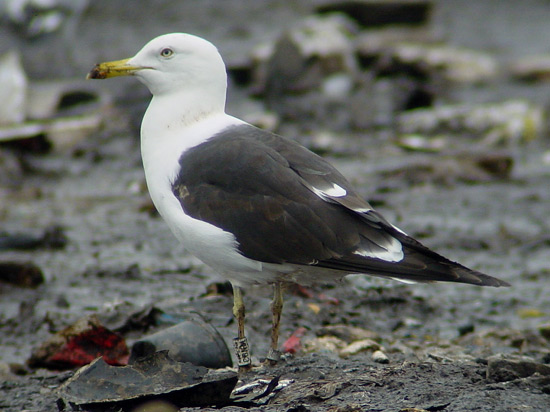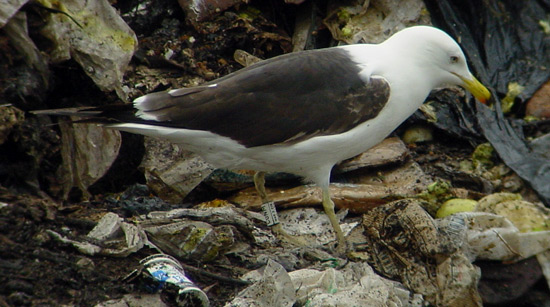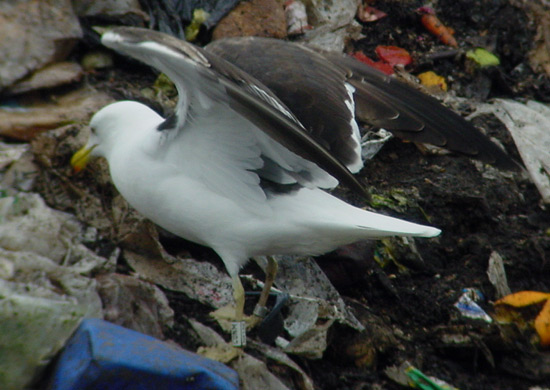
(3 images) Larus fuscus fuscus 3cy C0NM, July 10-17 2003, Tampere, Finland (61.33N 24.59E).
C0NM was ringed in Kanala, Finland; ringed as
pullus June 24 2001.
Recorded
at Tampere: 2003-05-30,
2003-05-31, 2003-06-01, 2003-06-28, 2003-06-29, 2003-07-05, 2003-07-09,
2003-07-10, 2003-07-11, 2003-07-12, 2003-07-15, 2003-07-16, 2003-07-17,
2003-07-20, 2003-07-23, 2003-07-24, 2003-07-26, 2003-07-27, 2003-07-30,
2003-07-31, 2003-08-02, 2003-08-03, 2003-08-12.
After August 09 2003, C0AV wasn't seen again at Tampere dump despite
intense visits and may have moved further south from that date on.
Larus fuscus fuscus in 2cy often returns
with completely replaced primaries and secondaries. In 3cy, fuscus more
often shows a clear division between fresh inner primaries and older outer
primaries, the inner primaries often showing neat white tips and the outer
primaries often second generation-like with rounded tips and paler bleached
brown. The arrested moult in the primaries is often reflected in the secondaries
and (to a less extend) in the tail-feathers as well. The older tail-feathers
(often R5 is older) still show a broad dark sub-terminal band.
3cy fuscus often have some black markings on the bill, which is otherwise
much adult-like, with a clear red gonydeal spot. The colour of the naked parts
are adult-like as well.
The scapulars in 3cy are often completely adult-like, lacking internal patterns;
plain blackish grey with a mahogany hue on the older feathers. Most wing-coverts
and tertials are adult-like blackish grey as well, but often 3cy birds show some
very bleached pale brown wing-coverts, normally in the greater covert bar and in
the upper rows of the lesser coverts. These bleached wing-coverts accentuate the
jumpy sequence in the last wing-covert moult cycles, as there is often no clear
pattern in location of these bleached feathers. Head and body feathers normally
are snow-white by July.
C0NM was ringed in Finland, now in 3cy. This 3cy fuscus
has the outer primaries bleached brown, with the white tips worn away. C0NM
probably continued primary moult after returning in Scandinavia; P1 is growing
by mid-July and P2-P3 are missing. P4-P10 are old with no mirror on P10,
suggesting these outer primaries are old 2nd generation flight feathers. This is
supported by the pattern on P4: there is hardly a white tip and the
sub-terminal band (often obvious on 3rd generation P4) is lacking; the pale brown
inner-web gradually dissolves in the darker brown outer-web. One has to be
cautious however, see the inner primaries e.g. CNMR,
which are 3rd generation.
All the secondaries were included in the moult on the wintering grounds,
showing grey bases and large white tips, the common pattern in 3rd generation
secondaries. However, at least S3 and S6 appear bleached brown and may be
retained 2nd generation secondaries. Most rectrices appear fresh with pretty neat tips and
are white without
any black markings when the tail is folded. In the field, they all proved to be
(at least) 3rd generation. Note the dark markings on the bill and the retained
bleached wing-coverts.
See also CNMR, another 3cy in active primary moult.


